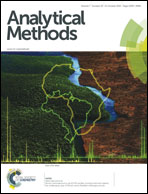Fluorescent carbon dots from beer for breast cancer cell imaging and drug delivery†
Abstract
We report the finding of the presence of fluorescent carbon dots in commercial beer and TEM analysis reveals that the beer carbon dots (BCDs) have an average size of 2.5 nm. The BCDs possessed high solubility and excellent fluorescence properties under the excitation of ultra-violet light with a quantum yield of approximately 7.39%. X-ray photoelectron spectroscopy (XPS) characterization demonstrated that the BCDs contain carbon, oxygen and nitrogen, three elements with the relative contents ca. 59.52%, 36.71% and 3.77%, respectively. X-ray diffraction (XRD) analysis indicated that the BCDs are amorphous. Fourier transform infrared (FTIR) spectroscopy was employed to characterize the surface groups of the BCDs. The BCDs showed excellent stability under different conditions (high ion strength, extreme pH and laser exposure). The cytotoxicity study revealed that there was no obvious inhibition of cell viability with a concentration as high as 12.5 mg mL−1 for 48 h, so that the BCDs could be directly applied in live cell imaging. Moreover, the BCDs could be used as efficient nanocarriers for the purpose of anticancer therapy. Doxorubicin-conjugated BCDs (BCD-DOX) induced prolonged cytotoxicity compared to free doxorubicin (DOX) due to the slow release of DOX from the BCD-DOX. The internalization of BCD-DOX by MCF-7 cells was further confirmed by using a laser scanning confocal microscope. All these results indicated that the BCDs present in beer have good biocompatibility and excellent fluorescence properties and may be considered as a safe material for bio-imaging and image-guided drug delivery in cancer therapy.


 Please wait while we load your content...
Please wait while we load your content...